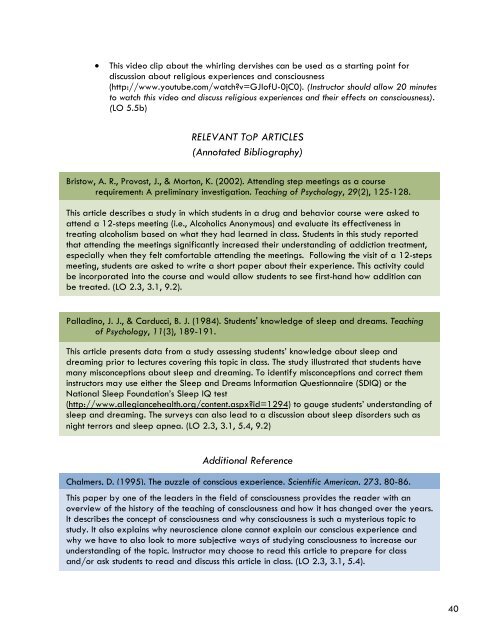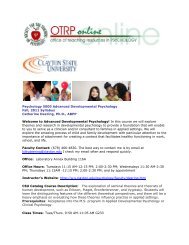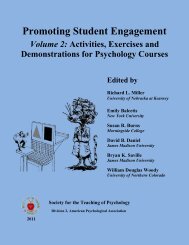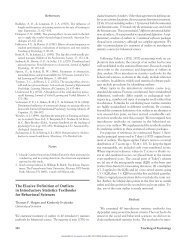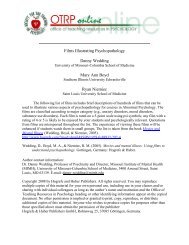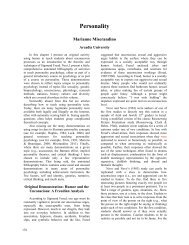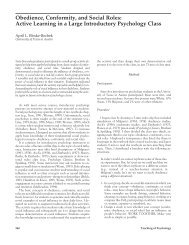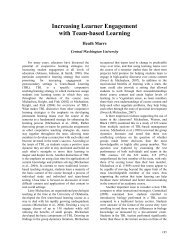INTRODUCTORY PSYCHOLOGY TEACHING PRIMER Early Career ...
INTRODUCTORY PSYCHOLOGY TEACHING PRIMER Early Career ...
INTRODUCTORY PSYCHOLOGY TEACHING PRIMER Early Career ...
You also want an ePaper? Increase the reach of your titles
YUMPU automatically turns print PDFs into web optimized ePapers that Google loves.
• This video clip about the whirling dervishes can be used as a starting point for<br />
discussion about religious experiences and consciousness<br />
(http://www.youtube.com/watch?v=GJIofU-0jC0). (Instructor should allow 20 minutes<br />
to watch this video and discuss religious experiences and their effects on consciousness).<br />
(LO 5.5b)<br />
RELEVANT TOP ARTICLES<br />
(Annotated Bibliography)<br />
Bristow, A. R., Provost, J., & Morton, K. (2002). Attending step meetings as a course<br />
requirement: A preliminary investigation. Teaching of Psychology, 29(2), 125-128.<br />
This article describes a study in which students in a drug and behavior course were asked to<br />
attend a 12-steps meeting (i.e., Alcoholics Anonymous) and evaluate its effectiveness in<br />
treating alcoholism based on what they had learned in class. Students in this study reported<br />
that attending the meetings significantly increased their understanding of addiction treatment,<br />
especially when they felt comfortable attending the meetings. Following the visit of a 12-steps<br />
meeting, students are asked to write a short paper about their experience. This activity could<br />
be incorporated into the course and would allow students to see first-hand how addition can<br />
be treated. (LO 2.3, 3.1, 9.2).<br />
Palladino, J. J., & Carducci, B. J. (1984). Students' knowledge of sleep and dreams. Teaching<br />
of Psychology, 11(3), 189-191.<br />
This article presents data from a study assessing students’ knowledge about sleep and<br />
dreaming prior to lectures covering this topic in class. The study illustrated that students have<br />
many misconceptions about sleep and dreaming. To identify misconceptions and correct them<br />
instructors may use either the Sleep and Dreams Information Questionnaire (SDIQ) or the<br />
National Sleep Foundation’s Sleep IQ test<br />
(http://www.allegiancehealth.org/content.aspx?id=1294) to gauge students’ understanding of<br />
sleep and dreaming. The surveys can also lead to a discussion about sleep disorders such as<br />
night terrors and sleep apnea. (LO 2.3, 3.1, 5.4, 9.2)<br />
Additional Reference<br />
Chalmers, D. (1995). The puzzle of conscious experience. Scientific American, 273, 80-86.<br />
This paper by one of the leaders in the field of consciousness provides the reader with an<br />
overview of the history of the teaching of consciousness and how it has changed over the years.<br />
It describes the concept of consciousness and why consciousness is such a mysterious topic to<br />
study. It also explains why neuroscience alone cannot explain our conscious experience and<br />
why we have to also look to more subjective ways of studying consciousness to increase our<br />
understanding of the topic. Instructor may choose to read this article to prepare for class<br />
and/or ask students to read and discuss this article in class. (LO 2.3, 3.1, 5.4).<br />
40


